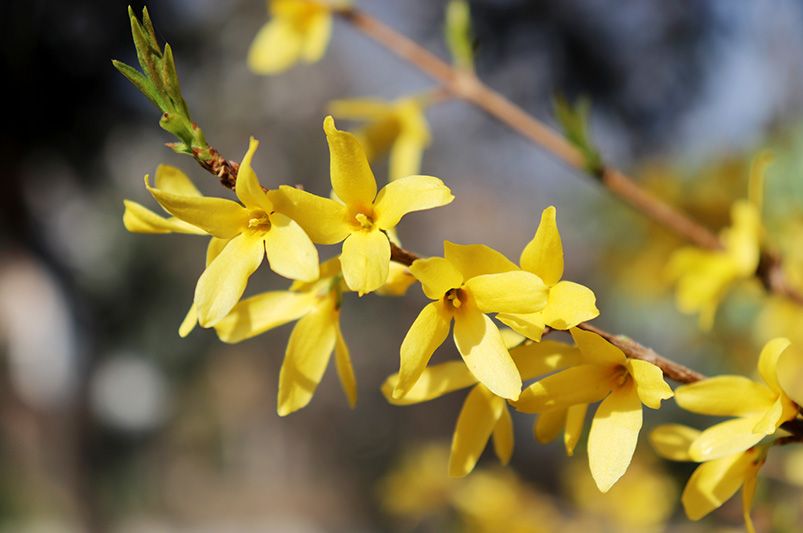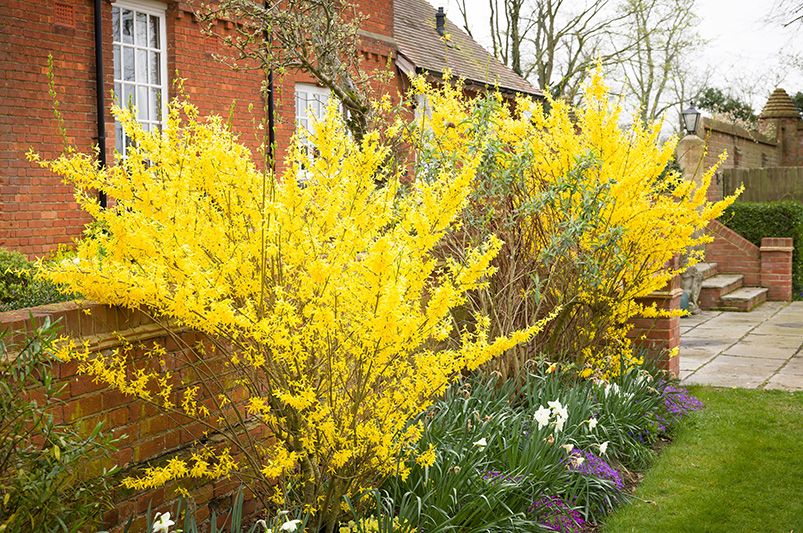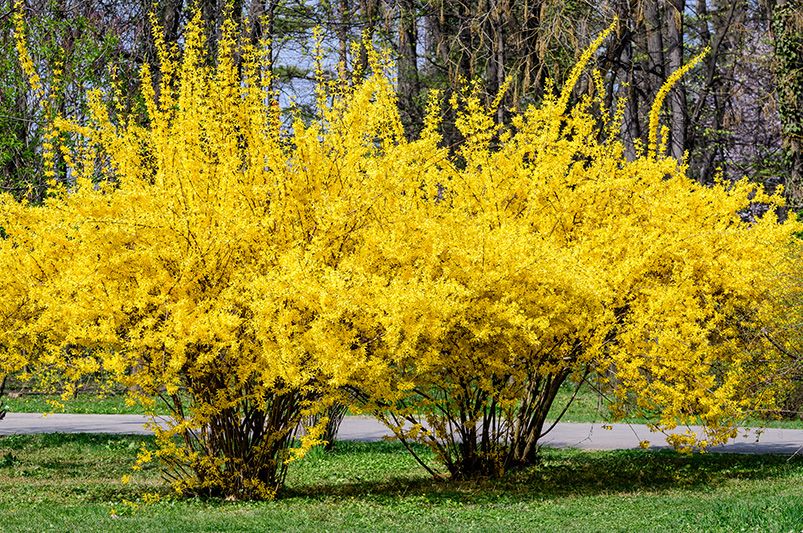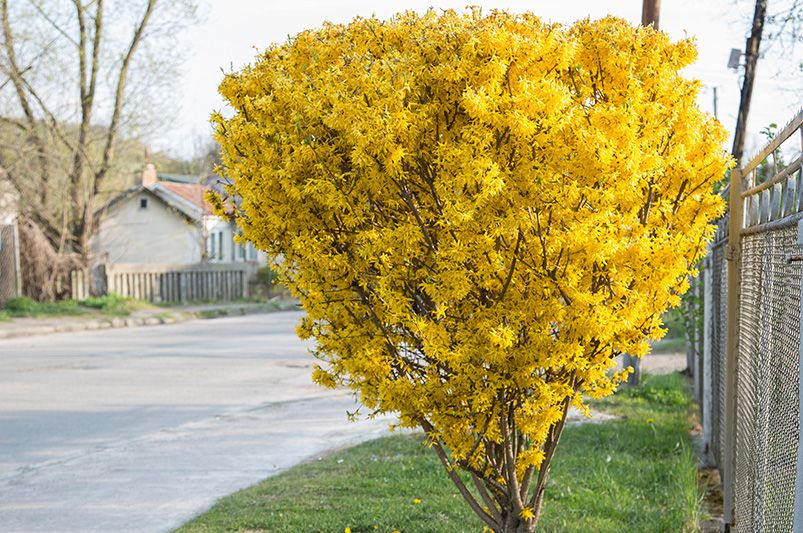
Forsythia Pruning in 10 Easy Steps
Published: 06/03/2024 | Updated: 06/04/2024
Forsythia is, unquestionably, one of nature's finest annual exhibits, bursting into a frenzy of dazzling color. As spring breezes in, bringing its typical blend of wet and sun-soaked days, this vibrant shrub lights up gardens with its bright yellow flowers. It’s a showy spectacle, indeed, but keeping your Forsythia looking brilliant, bushy, and beautiful year after year calls for a bit of devotion, particularly when it comes to pruning.


Pruning might seem rather daunting, especially when you're faced with an overgrown Forsythia that is wildly taking over your space or hasn't been tended to for several seasons. But fear not – with the right guidance, even novice gardeners can tame Forsythia in a way that honors their natural shape and ensures an abundant bloom in early spring. In this article, we’ve not only rounded up an in-depth overview to help you understand your plant but also listed 10 easy steps for pruning Forsythia.
Origins and Characteristics
Native to regions of Eastern Asia and Southeastern Europe, Forsythia comprises about 11 species, most of which are deciduous shrubs, and their embellishment in gardens or parks as ornamental plants stands as a testament to their aesthetic appeal.
The name "forsythia" honors the Scottish botanist William Forsyth, founder of the Royal Horticultural Society. Interestingly, beyond the ornamental features, the plant's early yellow blooms find resonance in East Asian art, culture, and traditional medicine, symbolizing anticipation and arrival, bringing more than just a vibrant hue to gardens across the globe.
Profoundly known for their untamed explosion of yellow across their branches, Forsythia shrubs span from small, compact variants reaching just a meter in height to towering beauties that can claim an impressive 3-meter height. The forsythia fascination is not limited to its striking bloom alone but extends to its simple yet distinct leaves that complement the floral splendor. Featuring serrated edges, the leaves often flaunt a dark green look with prominent veins journeying the surface.
Growing Conditions
Beyond the allure lies the rugged, hardy character of Forsythia shrub. Renowned for their tolerance of various soil types and impressive resistance to environmental stressors, Forsythia bushes stand as a symbol of resilience in the plant world. From rocky to smooth silt soil, and sporadic exposure to the sun to embracing full sunlight, the Forsythia adapts, prospering even in less-than-ideal conditions.
If you are not quite sure whether Forsythia is a good choice for your landscape design, you can always seek the guidance of ShrubHub’s talented designers and plant experts to help you grow the right blooms in your outdoor space. However, if you already have this adorable shrub in your yard, it’s time for you to learn how to prune Forsythia through the following 10 easy steps.

Pruning and Maintenance
Step #1- Timing Your Pruning
When it comes to pruning Forsythia plants, timing is everything. The best time for pruning Forsythia is immediately following the spring bloom. Why is that? Forsythia develops blooms for the subsequent year shortly after the current year's flowers fade. So, planning your pruning just after the blooming period means you're fostering a healthier environment for next year's new growth. By understanding Forsythia's blooming cycle, you'll not only ensure healthy growth but more vibrant blooms in the coming seasons.
Step #2- Gathering Your Tools
The right toolset can make all the difference in properly pruning your plant. Start with a sturdy pair of handheld pruning shears, perfect for nipping off smaller Forsythia branches and twigs. For tackling larger branches, you'll want a pair of lopping shears; these have the strength and leverage necessary to shear through branches as thick as 1.5 inches. If there are any branches thicker than the loppers can handle, a pruning saw is a wonderful tool. Assemble these tools in a convenient spot where you can easily reach them during your work.
Step #3- Sanitizing Your Tools
One of the most critical but often overlooked steps in the pruning process is sanitizing your tools. Just as a surgeon would never use a dirty scalpel, a gardener should always start with clean, disinfected pruning equipment. This step is crucial to prevent the transfer of diseases or pests from one plant to another.
Before starting the Forsythia pruning process, prepare a sanitizing solution by mixing one part bleach with nine parts water. Soak your pruning shears, loppers, or any other tools you are planning to use in the solution for approximately 30 minutes. Then, rinse and dry them thoroughly to prevent corrosion. Repeat this process every time you move from one plant to another, and again once you've finished pruning for the day. It's a straightforward step that can make a significant difference in protecting the health of your Forsythia and other plants in your garden.

Step #4- Assessing Your Forsythia
Before the shears meet the branch, stand back and take in the overall shape and structure of the plant. This initial observation will help you determine the extent and type of pruning required. Keep an eye out for diseased, damaged, or dead branches– these will need to be pruned out regardless of your plant's overall health. It's also important to identify branches that are growing in undesirable directions such as towards your home or crossing over other branches. Understanding the health and form of your Forsythia leads to informed decisions during the pruning process, bolstering its growth and improving its overall appearance.
Step #5- Making the Initial Cuts
Once you've assessed your Forsythia and your tools are sanitized, it's time to make the initial cuts. Start with the three "Ds": any branches that are Dead, Diseased, or Damaged. Using your sharp, clean pruning shears, cut these branches back to the base of the plant or a main stem, taking care to make precise, clean cuts. This is a crucial first step in the pruning process, promoting the healthier, more vigorous growth of your Forsythia.
Step #6- Thinning Out the Shrub
After taking care of problematic branches, it's time to thin the shrub. This involves selectively removing branches at their point of origin to make sure the plant’s interior receives sunlight and to improve air circulation. Aim to remove roughly one-third of the oldest stems each year. By carefully thinning the Forsythia, you ensure balanced growth, reduce disease vulnerability, and enhance the shrub's overall appearance and health.
Step #7- Shaping the Forsythia
After removing deadwood and thinning the shrub, proceed to tame its overall shape. Trim the tips of the branches as needed to fit your aesthetical expectations or to regulate the plant's size. Ensure your cuts occur a few millimeters above the flower buds, ideally ones facing the direction you wish next season's growth to take.
Step #8- Removing Suckers
Being vigilant about sucker growth is imperative. Forsythia is notorious for sending up suckers or shoots from the base. These can swiftly spread, making your shrub look unruly. Unless you're intentionally cultivating a thicket, it's advisable to remove these suckers, cutting them off at ground level.
Step #9- Disposing of Trimmings
Post-pruning, it's essential to dispose of your trimmings properly. Not only does this make your garden tidy, but it also minimizes the risk of disease spread. If your Forsythia is healthy and free from pests, feel free to compost the trimmings. However, if you've pruned out diseased branches, discard them securely in garden waste bags to prevent any potential contamination of other plants. Remember, responsible disposal is integral to a healthy garden.

Step #10- Aftercare
Pruning can be quite an ordeal for a plant. Show your Forsythia love with some tender aftercare. Water it deeply, especially if the weather has been dry. Consider adding a layer of mulch around the base to retain moisture. Also, applying a slow-release, balanced fertilizer can provide the newly pruned Forsythia the nutrients to sprout healthy new growth.
Also, if you have other plants in your yard that need pruning or constant care, take a tour through ShrubHub’s lively blog. It’s simply a treasure chest full of engaging articles related to plants, landscape design, and practical gardening tips. So, no matter if you want to get the most out of your New York small yard or if you are eager to know how to prune fall raspberries, you’ll find the answer in our blog!
Where to Buy Forsythia
While pruning this stunning shrub might seem like a daunting task, breaking it down into manageable steps makes it an achievable chore, even for novice gardeners. From sanitizing your tools to assessing the plant, making the right cuts, thinning the shrub, and disposing of trimmings responsibly, each step plays a crucial role in maintaining the health and vibrancy of your Forsythia.
You must be wondering where to buy this beautiful shrub to reward your outdoor space with clouds of bright yellow blooms. For a trustworthy garden marketplace, all you have to do is visit ShrubHub. It not only houses a wide variety of Forsythia plants like Citrus Swizzle Forsythia, Gold Cluster Forsythia, Gold Tide Forsythia, and Show Off Forsythia, but it also offers you the luxury of choosing from our extensive collection of plants, curated to thrive in every zone.
Visit our store now and create a garden that never goes out of style!


